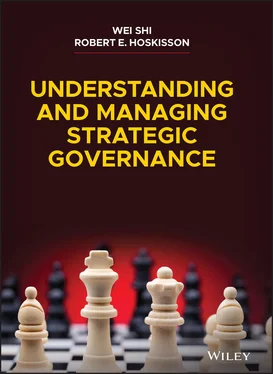By making employees owners, such ownership can lead to a convergence of interests between employees and shareholders. 66 Ownership gives employees a voice in corporate governance through their voting power, which can prevent firms from maximizing the interests of shareholders at the expense of those of the workers. 67 Yet in the United States, although employees can influence corporate governance through their ownership, they typically do not have board representation, 68 leaving employees with little say in boardroom discussions. As a result, directors often compromise employee interests to satisfy the interests of shareholders in firm decision-making. 69 To address this issue, several pieces of federal legislation have been introduced to grant employees the right to sit on corporate boards. For example, the Reward Work Act introduced by US senator Tammy Baldwin would empower workers by requiring public companies to directly elect one-third of their company's board of directors and reduce open-market stock buybacks. 70
As shown in the Strategic Governance Highlight ( Box 1.2), Germany and other Western European countries have a two-tier board consisting of a board of directors and a supervisory board. In this system, the law guarantees employee representation on corporate boards of directors as a recognized fundamental worker right. Employees can vote for representatives in supervisory boards under corporate law, which is often referred to as co-determination . Like many Western European countries, China requires publicly traded companies to have a supervisory committee. Such a committee must include employee representatives elected by personnel through an assembly of some or all employees, or by other means. Although employee representation on boards does not necessarily lead to higher profits and faster growth, it can inevitably change the power dynamics of corporate boards, 71 leading directors to pay closer attention to worker interests when making strategic decisions.
As illustrated in Figure 1.1, we provide an overview of the book's organization, focused on introducing strategic challenges that boards of directors face and how to overcome them. In this beginning chapter, we presented the concept of strategic governance, seeking to illustrate that boards of directors and the top management team are confronting a more intense governance situation in which prominent stakeholders pursue goals beyond board monitoring, seeking to affect corporate and business level strategies. Reinforcing this idea, a recent survey of board of director members by PwC, a large accounting advisory firm, rated strategic oversight as the most important aspect of a board member when that member engages in direct communications with shareholders. 72 In the following chapters, we will clarify how boards and other governance actors affect a range of strategies.
Chapter 2, a companion chapter to internal governance (Chapter 1), overviews external governance actors in the United States and other countries. External governance actors consist of institutional investors, activist investors, financial analysts, business media, short sellers, suppliers, customers, rating agencies, and regulators. We go more in depth on how these actors influence changes in strategic governance, not only through the board of directors but also through their advocacy and direct intervention.
Chapter 3investigates the role of governance actors in corporate strategies including diversification strategy, mergers and acquisitions, alliances, and divestitures. We also provide guidance on how corporate executives can manage conflicting governance actor demands when making corporate strategic decisions.
Chapter 4examines how governance actors affect internal innovation investment and corporate entrepreneurship with a focus on entering new product markets through internal innovation, corporate venture capital, joint ventures, and direct acquisitions. Here, we likewise discuss how to leverage governance actors to best foster innovation and enter a new product market.
Chapter 5focuses on the influence of governance actors on competitive strategies, such as the pursuit of differentiation versus cost leadership strategy, competitive aggressiveness, and competitive complexity. We introduced some of the influence on competitive strategies in regard to the audit committee's prospector- versus defender-oriented strategies. We will go more in depth and explore how company leaders can leverage governance actors to create better competitive strategy.
The global business environment has dramatically changed in the new competitive era. In Chapter 6, we provide an overview of the role that governance actors play in shaping firms' strategic choices for global expansion. Directors and top managers may also find ways to manage the governance influencers to increase the success of global strategies.
In Chapter 7, we discuss how governance actors shape firms' management of key stakeholder relationships, such as customers and suppliers, besides shareholders. We provide our guidance on leveraging internal and external governance actors to design successful stakeholder relationship strategies.
Corporate political strategy pertains to managing relationships with government actors. Firms can invest in lobbying, make political campaign contributions, and appoint directors with political ties to foster relationships with government actors. In Chapter 8, we explain the role of governance actors in corporate political strategy and how these actors can best be managed to facilitate an effective corporate political strategy.
In our final chapter, Chapter 9, we conclude with a summary of the strategic challenges that boards of directors face and provide additional recommendations for dealing with these challenges. We emphasize the growing governance issue under disruptive innovation associated with platform strategy such as that of Amazon, Apple, Uber, and many others, as well as digitalization. We also discuss policy implications and emerging trends at the interface of governance and strategic decisions.
1 1. Boyson, N. M., Gantchev, N., & Shivdasani, A. (2017). Activism mergers. Journal of Financial Economics 126(1): 54–73; Shi, W., Connelly, B. L., Hoskisson, R., & Ketchen, D. (2020). Portfolio spillover of institutional investor activism: An awareness-motivation-capability perspective. Academy of Management Journal 63(6): 1865–1892.
2 2. Welch, D., Deveau, S., & Coppola, G. (2020). Activist battling Harley's board urges focus on core riders. Bloomberg.com, www.bloomberg.com, March 20.
3 3. Benner, M. J., & Zenger, T. (2016). The lemons problem in markets for strategy. Strategy Science 1(2): 71–89. Zenger, T. (2013). Strategy: The uniqueness challenge. Harvard Business Review 91(11): 52–58.
4 4. Uribe, A., & Scism, L. (2020). Companies are paying a lot more to insure their directors and officers. Wall Street Journal, www.wsj.com, June 21.
5 5. Chandler, A. D. (1977). The visible hand –The managerial revolution in American business. Cambridge: Harvard University Press; Herman, E. (1981). Corporate control, corporate power. New York: Cambridge University Press.
6 6. Boyd, B. K., & Hoskisson, R. E. (2010). Corporate governance of business groups, In A. M. Coplan, H. Takashi, & J. Lincoln (Eds.), The Oxford Handbook of Business Groups. New York: Oxford University Press.
7 7. Aiken, A. L., & Lee, C. (2020). Let's talk sooner rather than later: The strategic communication decisions of activist blockholders. Journal of Corporate Finance 62; Jahnke, P. (2019). Ownership concentration and institutional investors' governance through voice and exit. Business & Politics 21(3): 327–350.
8 8. Shi, W., Connelly, B. L., & Hoskisson, R. E. (2017). External corporate governance and financial fraud: Cognitive evaluation theory insights on agency theory prescriptions. Strategic Management Journal 38(6): 1268–1286.
Читать дальше












